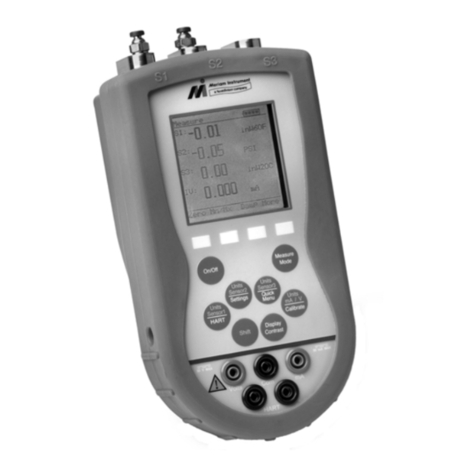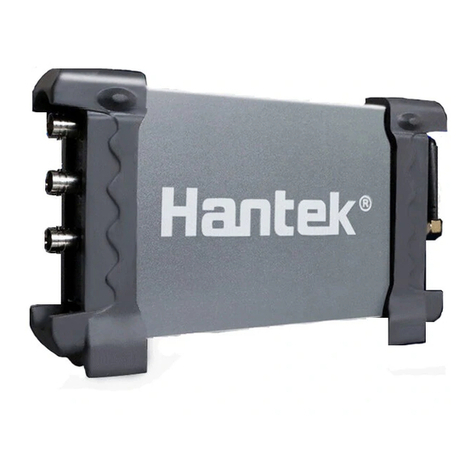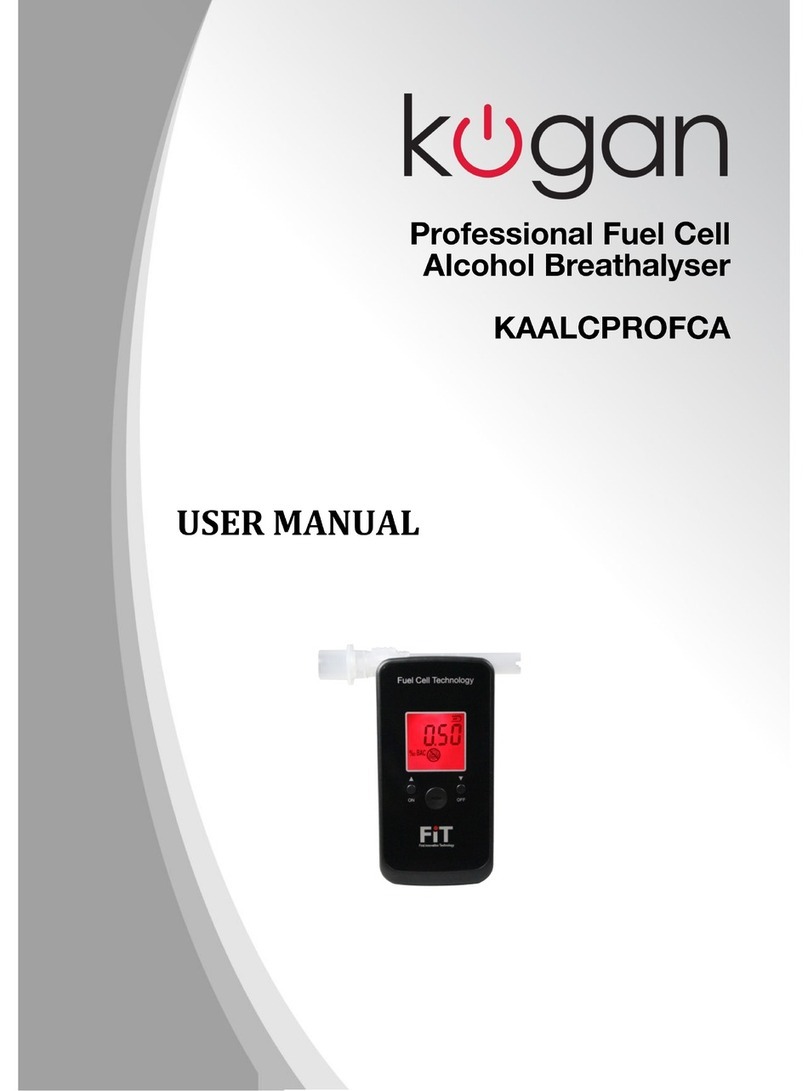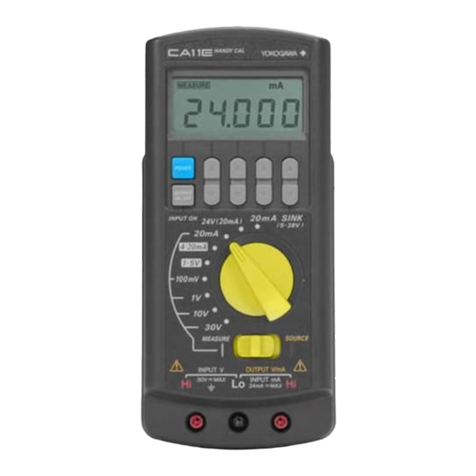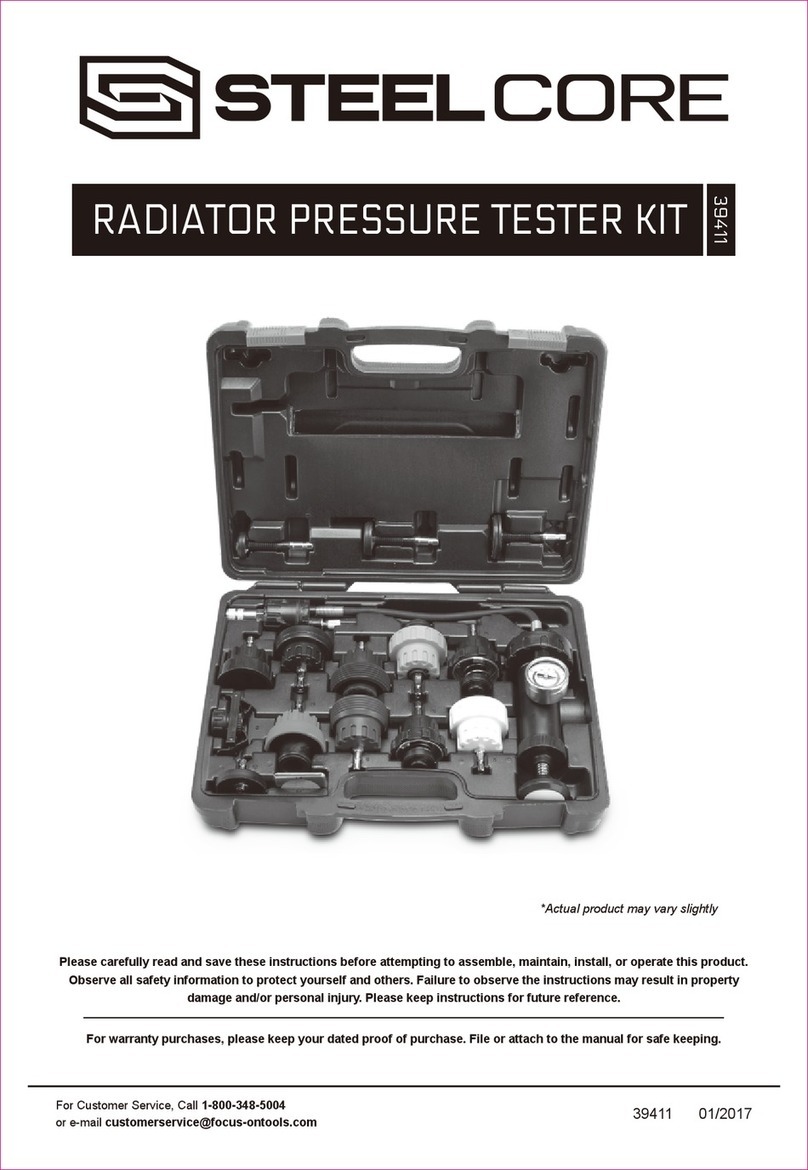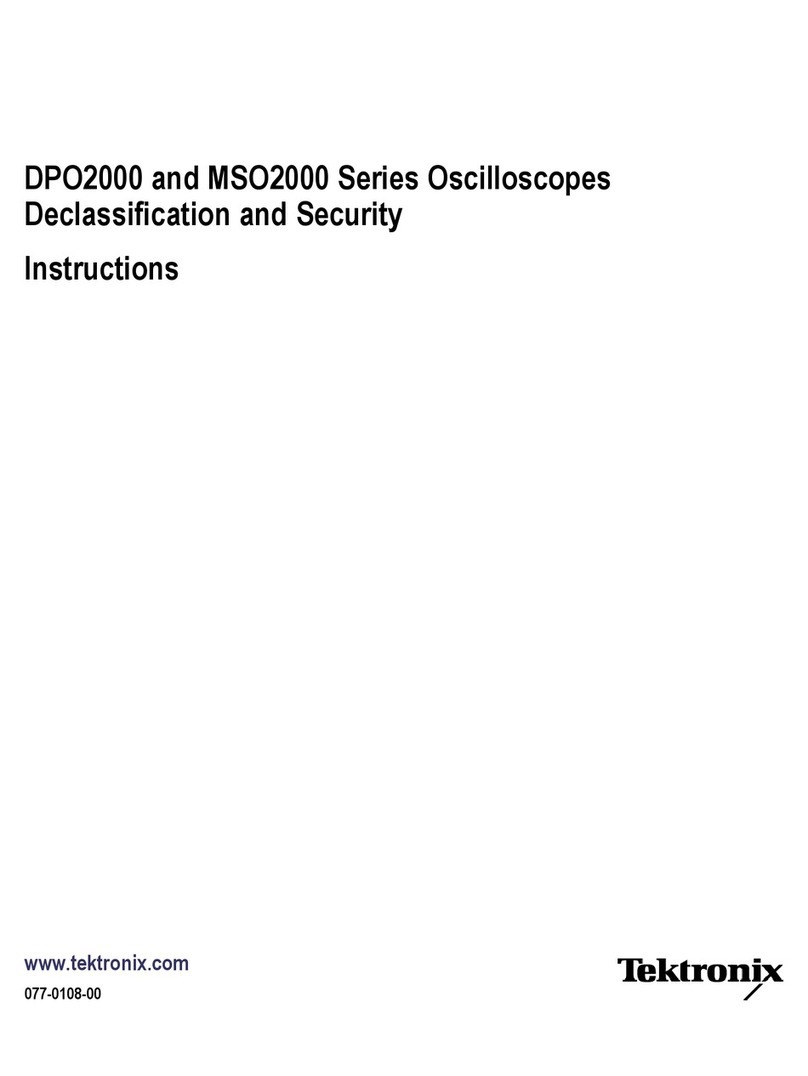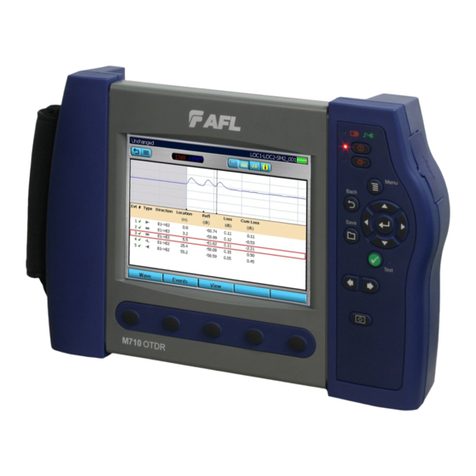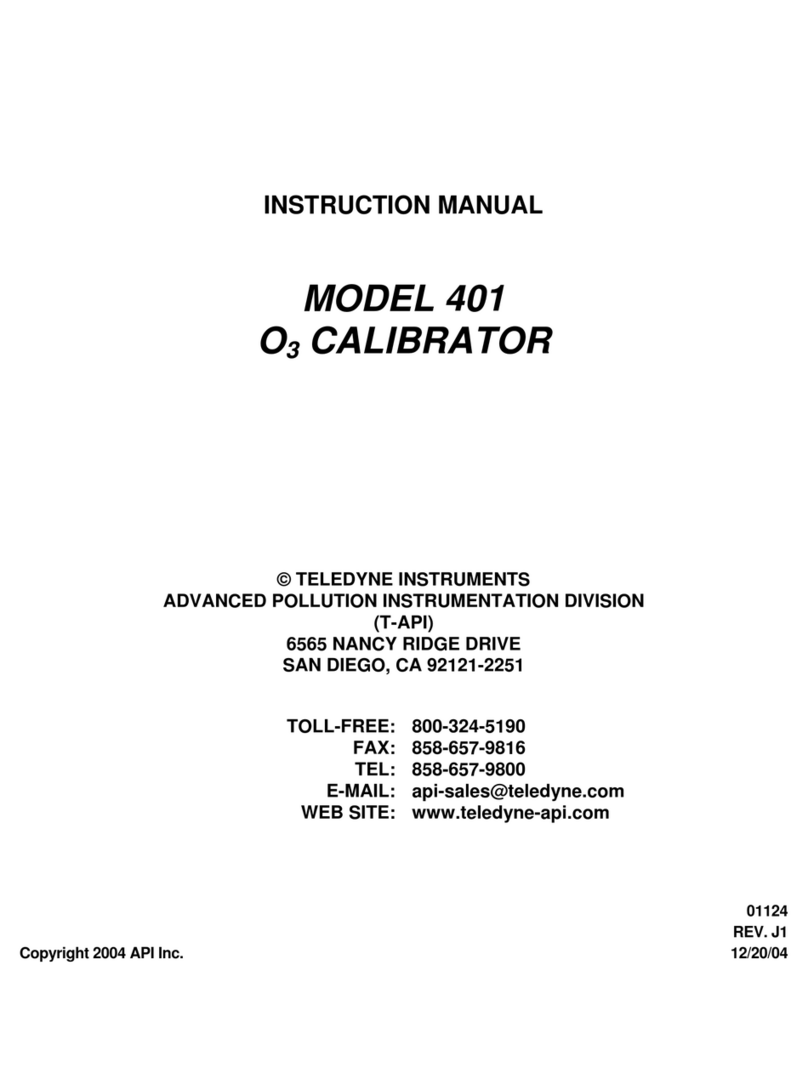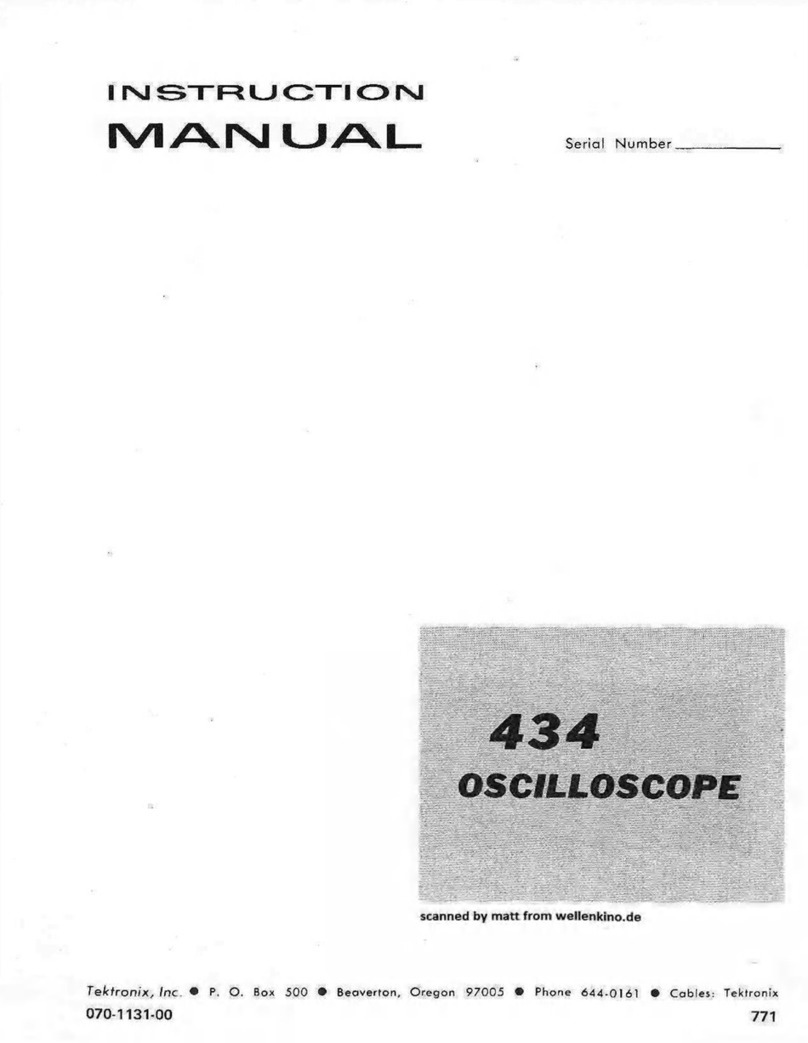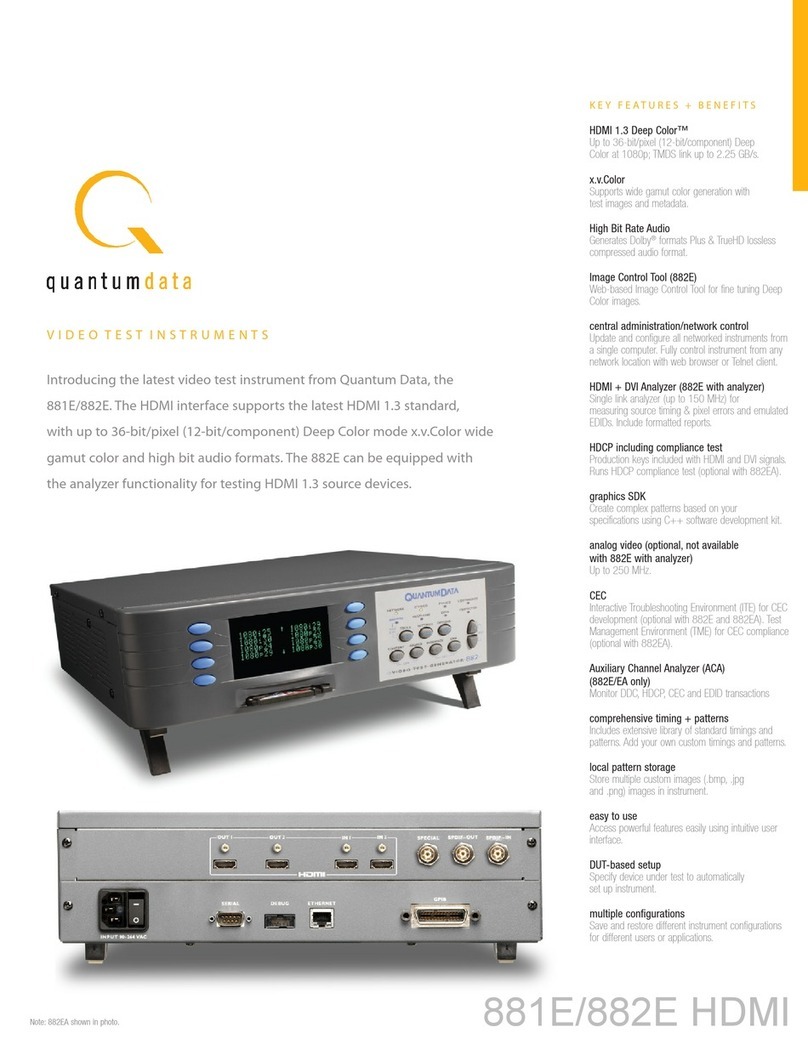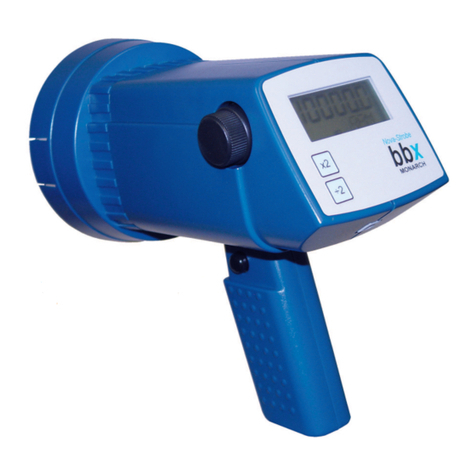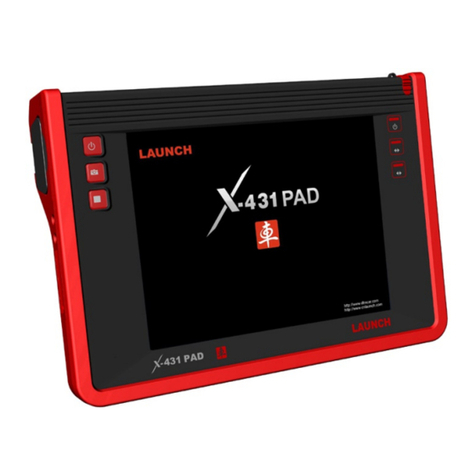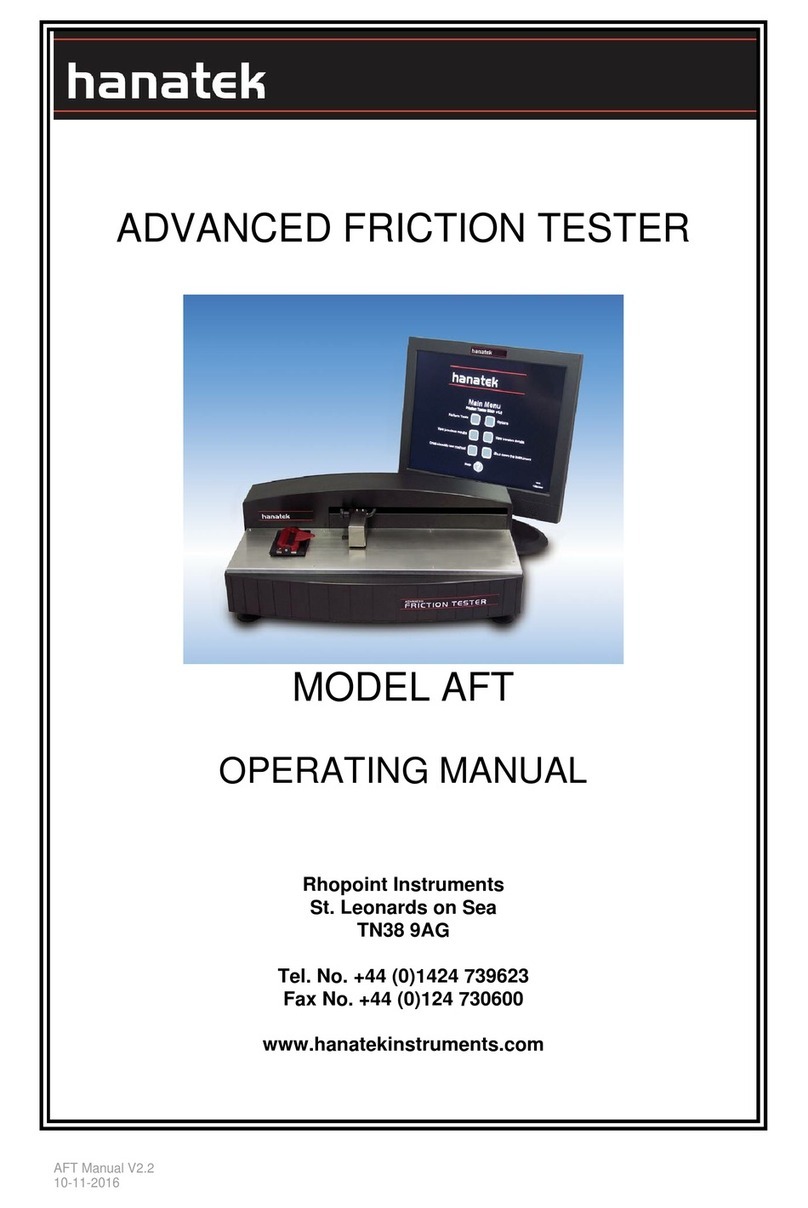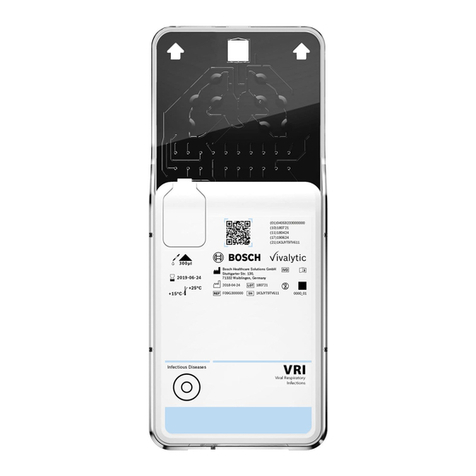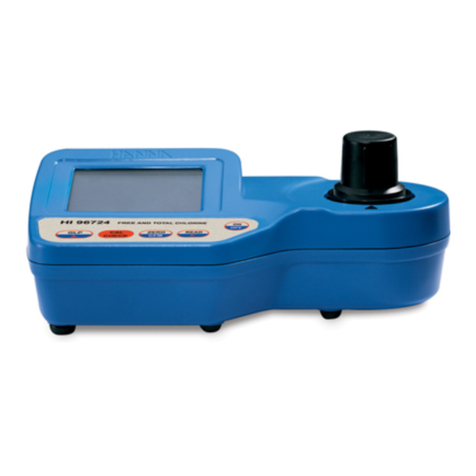Global Leak KLI9210 User manual

EVAPORATIVE
EMISSIONS
TESTER
KLI9210
OPERATION
MANUAL
STAR EX. 2012
Redline v. Star EnviroTech
Case IPR2013-00106


Table of Contents
GENERAL INFORMATION..................................................................................1
UNPACKING & SETUP .......................................................................................2
Inlcuded Accessories ................................................................................2
CHECK LIST........................................................................................................4
SELF-TEST INSTRUCTIONS..............................................................................4
CALIBRATING & TESTING FOR LEAK STANDARD (.020˝ - .040˝) .................. 5
TESTING AT VEHICLE TEST PORT...................................................................6
TESTING AT FUEL FILLER NECK.....................................................................7
TESTING AT FUEL CAP .....................................................................................8
TESTING ENGINE W/O TEST PORT..................................................................8
TESTING WITH VEHICLE CAP HOSE ASSEMBLY...........................................9
LOCATING LEAKS USING SMOKE GENERATION UNIT.................................10
LOCATING LEAKS USING ULTRASONIC LEAK DETECTOR..........................11
TROUBLESHOOTING TIPS................................................................................12
USING ACCESSORIES.......................................................................................13
AVAILABLE ACCESSORIES..............................................................................14
REPLACEMENT PARTS REFERENCE..............................................................15
WARRANTY.........................................................................................................16
ALL RETURNS....................................................................................................16
Page i

Two simple procedures are required to fully assemble Tester:
1. Install Tester’s flow meter onto control panel.
2. Mount Nitrogen tank onto cart (nitrogen tank not supplied). Install supplied high
pressure regulator onto Nitrogen tank.
NOTE: See pages 2 & 3 for detailed assemply instructions.
Rear View
View: As Assembled from Factory
Page ii

View: Fully Assembled
Front View
KLI9210KIA
Packing List:
EVAP Smoke Generator w/ cart
–Part # 44KLI9210
Test kit
–Part # 4510000-AD,
containing:
-2 exhaust cones (prt # 4410000-122),
-cap plug kit (prt # 4410000-106),
-smoke diffuser (prt # 4410000-121)
-threaded nozzle adapter (prt # 4410000-102)
Threaded cap adapter
–Part # 4410000-80
Threaded cap receiver
–Part # 4410000-81
Vehicle cap test hose
–Part #4410000-82
12-VDC halogen light
–Part # 4410000-100
Page iii

View: Control Panel
Self -Test/
Calibration
Fittings
Pressure
Gauge
12 Volt DC Power
Supply Receptacle
System Control
Valve
Self Test
.040” (1 mm)
.020” (0.5 mm)
Flow
Meter
Page iv

KLI9210 User Operation Manual
1
GENERAL INFORMATION
The KLI9210 Evaporative Emission System Tester is designed to test for emission leaks in the fuel
and evaporative emissions systems of vehicles equipped with OBDII on-board diagnostics. If a leak is
detected in the fuel or evaporative emissions systems (refer to the vehicles manufacturer’s service
manual for fault code information), the tester will pressure check the system for easy leak detection
and location. With the system properly pressurized by the KLI9210 test unit, leak size (by the use of
the flow meter) and location (by the use of the Smoke Generation Unit and/or the use of other
accessories) can be determined and repaired.
The KLI9210 comes with all the equipment necessary to properly diagnose the system, except for the
nitrogen gas cylinder needed to pressurize systems during the test process. Nitrogen gas cylinders are
available from your local gas suppliers. We recommend the common industrial size tank, reference: D
or S tank.
The KLI9210 Evaporative Emissions System Tester w/Smoke Generation Unit can, with the purchase
of additional accessories, also find leaks in the following systems. See page 14 for list of accessories.
1. Manifold system leaks
2. Exhaust system leaks
3. Under-dash vacuum system leaks
4. Turbo charger leaks
5. Wind and water leaks in the passenger compartment
CAUTION!!! IMPORTANT!!!
Read Before Operating Unit!!!
NEVER attach the KLI9210 to any combustible gas! Adding air containing
oxygen to the fuel evaporative system could create a flammable mixture
inside the vehicle’s fuel tank!
Use ONLY Nitrogen gas cylinders that are properly maintained and in good working order. The
KLI9210 is supplied with a specific regulator (pipe thread: 960-14 NGO, an industrial standard) for
pressure control designed for use only with nitrogen gas cylinder tanks. Unit must be used only
according to these instructions; failure to follow these instructions may lead to personal injury and
property damage.
NEVER depress the remote smoke trigger before first turning ‘ON’
the nitrogen supply to the tester!

KLI9210 User Operation Manual
2
Fig. 1 - Front view
UNPACKING & SETUP
The KLI9210 Evaporative Emissions System
Tester ships with all the necessary adapters,
Flow Meter, regulators and the Smoke
Generation Unit plus any additional accessories
that were ordered with the unit.
1. Remove all items from the shipping boxes.
You should find the following:
Included Items:
EVAP Smoke Generator with cart –
Part # 44KLI9210
Test kit – Part # 45-10000-AD, including:
2 exhaust cones (prt # 4410000-122), cap plug kit (prt #
4410000-106), smoke diffuser (prt # 4410000-121) and
threaded nozzle adapter (prt # 4410000-102).
Threaded cap adapter – Part #. 4410000-80
Threaded cap receiver – Part # 4410000-81
Vehicle cap test hose – Part # 4410000-82
12-VDC halogen light – Part # 4410000-100
See page 14 for additional accessories.
2. Tester arrives almost fully assembeled. Store any adapters,
light and other accessories included with the Tester in
lower storage bin (fig. 1).
3. Make sure that the slots on both storage bins are seated on
the cart brackets provided. The entire edge of the plastic bin
should fit over the hanging bracket with the 2 tabs sticking
through the holes in each bin. (fig. 2).
IMPORTANT INFORMATION:
Read Before Operating Unit!
The smoke generation unit supplied with the KLI9210 is fully tested at the factory, drained and shipped with-out fluid in
unit. Prior to use, the smoke generation unit must be filled with smoke generation fluid supplied with unit. Completely
drain the fluid container into the smoke generation unit filler neck and dispose of the container according to your local/state
requirements.
It’s important to check the solution level and top off to the “Full” mark on the dipstick regularly,
just as you would regularly check the oil level of a car’s engine.”
Fig. 2
Back view
TAB
OIL FILL TUBE

KLI9210 User Operation Manual
3
- cont’d
4. Locate the Flow Meter assembly and mount it on the right
side of cart; making sure Meter is facing the front of cart,
(the side the Gas Cylinder bottle is located). Mounting is
done by simply removing the two screws from the back
of the flow meter and attaching it to the bracket (fig. 3) by
replacing the screws through the two holes in the bracket.
Do NOT over-tighten!
5. Locate the Regulator Assembly and connect it to the
Nitrogen Gas Cylinder (fig. 4) (Gas Cylinder Not
Supplied).
IMPORTANT SAFETY POINT:Make sure the
Gas Cylinder is securely fastened to the cart, with the two
fastening straps provided, at all times (fig. 1).
6. Connect the black hose from the Regulator Assembly to the
bottom port on the Flow Meter (fig 3). Tighten with
wrench but DO NOT OVER-TIGHTEN!!!
This completes the unpacking and set-up instructions. If
you have any questions regarding proper unpacking or set-up contact Global
Leak Detection, Corp customer service at 1-877-669-2841 and request
clarification.
IMPORTANT INFORMATION:
Read Before Operating Unit!
This unit requires a nitrogen gas cylinder [not supplied with unit] be attached to it in order to function correctly.
The gas used MUST be nitrogen gas. Mount the bottle to the front of the EVAP cart and strap it in with the
supplied retainer straps. Connect the supplied regulator to the bottled gas container and tighten. IMPORTANT:
DO NOT OVER TIGHTEN!!!
Fig. 3
Fig. 4
Regulator HoseScrews

KLI9210 User Operation Manual
4
CHECK LIST
1. Be sure that both vehicle being tested and the KLI9210 are at room temperature. These tests are
based on 14 inches of water, or less than ½ PSI. Any variation can cause false readings.
2. When the KLI9210 is not in use ALWAYS move the Control Valve to the HOLD position and turn
the Gas Cylinder Valve OFF. This will prevent loss of nitrogen gas due to valve being left open or a
vehicle component not working correctly.
3 Follow all procedures in “Vehicle Manufacturer’s Service Manual.” On some vehicles, valves and/or
hoses may need to be shut or closed off.
IMPORTANT SAFETY POINT:
Always disconnect 12 Volt power connectors from power source when not in use.
IMPORTANT INFORMATION:
The vehicle’s fuel tank should be between ¼ and ¾ full for performing tests. Having the
fuel tank over ¾ full could cause fuel to back up into tester when the system is
pressurized.
SELF-TEST INSTRUCTIONS
IMPORTANT SAFETY POINT:
Make sure the Nitrogen Tank is properly hooked up and positioned at all
times.
1. Make sure the control valve on the panel is in the HOLD position and
open the nitrogen bottle.
2. Connect Vehicle Interface Hose to the Self-Test Port (fig. 5) located on
the Control Panel. Hand-tighten the fitting;
DO NOT OVER-TIGHTEN!!!
3. Turn Control Valve to TEST position (fig. 6).
4. Gauge should read 14 inches of water, plus or minus 1 inch.
(This is pre-set at the factory. If gauge is not reading in this range,
please adjust the pressure by turning the black knob on the Low Pressure
Regulator at the tank until the gauge reads 14 inches of water.)
5. Turn Control Valve to “HOLD” position.
6. Note whether the gauge holds pressure and check that the Flow Meter
reads NO flow. (If the gauge leaks down, confirm that the vehicle interface
hose is connected firmly and re-test. If gauge leaks down again, try to
determine cause of leak. Otherwise contact Global Leak Detection
customer service/technical support at 1-877-669-2841 for instructions.)
7. No drop in pressure or flow — unit passed self-test.
Fig.
6
Fig. 5
SELF TEST
.040
.020

KLI9210 User Operation Manual
5
CALIBRATING & TESTING FOR
LEAK STANDARD (.020˝ -.040˝)
When calibrating unit you will need to determine what standard
to test to. Please refer to Vehicle Manufacturer’s Service Manual
for this information.
1. Complete the Self-Test, on previous page, to assure the
machine is set-up properly.
2. Make sure the Control Valve is in the HOLD position and that
the valve on the cylinder of nitrogen gas is open.
3. Find the Preset test orifice on the front of the KLI9210 that
reflects the standard (.020˝or .040˝) you are testing to (fig. 7).
Connect the KL19210 vehicle interface hose to the preset and
turn the control valve to the TEST position.
4. Mark the Flow Meter reading with the pointer flag (fig. 8)
(.020˝ should read in the lower range of the Flow Meter and the
.040˝ should read in the higher range of the Flow Meter).
5. Run either test on the vehicle or fuel cap as described in the
instructions for each test procedure that follows this section.
6. Compare the flow reading, while the system is connected to
the vehicle with the system pressurized to the pointer, for the
leak size specification for the vehicle.
7. If the flow ball reading is above the calibrated flow marker
(fig. 8), then the vehicle failed the test and a repair is
required. If the flow reading is below the calibrated flow
market, then vehicle passed the test and no further action is
required.
8. Turn the control valve to the HOLD position.
9. Refer to “Locating Leaks Using Smoke Generation
Unit” – page 10 & “Locating Leaks Using Ultrasonic
Leak Detector” – page 11 for further instructions.
Fig. 7
Fig. 8
SELF TEST
.040
.020

KLI9210 User Operation Manual
6
TESTING AT VEHICLE TEST PORT
1. Make sure the tester’s control valve is in the HOLD position and that the valve on the nitrogen gas
cylinder is turned to open.
2. After completing Self-Test Instructions, locate Vehicle’s
EVAP Test Port Fitting Cap (fig. 9) and unthread it.
Connect the KLI9210’s Vehicle Interface Hose directly
to the test port fitting (fig. 10) (This fitting is normally
located under the hood of the vehicle and towards the fire
wall. It can be located on either side of the vehicle. In
most, if not all, cases the cap on the EVAP Test Port
Fitting is green in color). HAND-TIGHTEN ONLY!!
a) Make sure to take all necessary steps to isolate isolate
the fuel system/EVAP system from the canister purge
valve/release valve, etc.
Note: Prior to step #2 above, you may remove service
port Schrader valve to improve smoke vapor performance. Schrader valve is Left-Hand
thread!
3. Turn nitrogen gas cylinder control valve to open position and tester control valve to TEST and let
the system fill with the nitrogen/smoke. You should note lower than 14 inches on the pressure gauge
along with the flow meter ball being pegged for several minutes, depending on the size of the tank
and the amount of fuel in the system. This is normal.
4. If after several minutes the gauge and the flow meter
ball does not settle to a measurable level, then refer to
Vehicle Manufacturer’s Service Manual to ensure
everything is shut off and the system is properly
isolated.
5. If there are no leaks in the system you will see “zero
flow” on the flow meter and the pressure gauge should
return to the preset pressure of 14 inches of H20. If you
do measure the flow and the pressure does not return to
the preset level of 14 inches of H20 then you have
determined that there is a leak in the vehicle’s
evaporative emissions system. Please proceed to
“Testing for the Leak Standard (.020˝ - .040˝)” – page 5.
6. If the flow reading is higher than the pointer flag (see
page 5, fig. 8), then the vehicle failed the test and a
repair must be completed on vehicle. If the flow reading is less than the flag, then the vehicle
passed the test and no further action is required.
7. Turn the control valve to the HOLD position.
Fig. 9
Fig. 10

KLI9210 User Operation Manual
7
TESTING AT FUEL FILLER NECK
1. After completing Self-Test Instructions, open the fuel door on the vehicle and remove fuel cap.
Install the appropriate Fuel Cap Adapter as illustrated below (fig. 11) into the vehicle’s Fuel Filler
Neck.
a) Make sure that all necessary steps are
taken to isolate the fuel system/EVAP
system from the canister purge
valve/release
2. Make sure the control valve is in the
HOLD position. Now connect the
KLI9210’s Vehicle Interface Hose directly
to the fuel cap adapter (fig. 11).
3. First, turn nitrogen gas cylinder Control
Valve to Open and then tester’s control
valve to TEST and let the system fill with the nitrogen/smoke. You should note a level of lower than
14 inches on the pressure gauge along with the Flow Meter ball being pegged for several minutes,
depending on the size of the tank and the amount of fuel in the system. This is normal.
4. If after several minutes the gauge and the Flow Meter ball does not settle to a measurable level,
refer to Vehicle Manufacturer’s Service Manual to insure that everything is shut off and the system
is properly isolated.
5. If there are no leaks in the system, you will see “zero flow” on the Flow Meter and the pressure
gauge will return to 14 inches of H2O. If you do see the Meter Ball above the calibration setting, as
outlined on page 5 and the pressure does not return to the preset level of 14 inches of H2O, you have
determined there is a leak in the vehicle’s evaporative emissions system. (Please refer to page 5 for
details on Testing to the Leak Standard)
6. If the flow meter ball is higher than the pointer flag (see page 5, fig. 8), then the vehicle failed the
test and a repair must be completed on this vehicle. If the flow reading is less than the tell tale flag,
then vehicle passed test and no further action is required.
7. Turn the control valve to the HOLD position.
Fig. 11

KLI9210 User Operation Manual
8
TESTING AT FUEL CAP
1. Make sure Tester’s Control Valve is in the HOLD position
and the valve on the nitrogen tank is turned open.
2. Remove fuel cap from vehicle.
3. Connect the appropriate Fuel Cap Receiver to the Vehicle
Interface Hose.
IMPORTANT:
HAND-TIGHTEN ONLY!!
4. Turn fuel cap into fuel cap receiver (fig. 12) and tighten
per cap instructions.
5. Turn the Control Valve to the TEST position
6. If the cap leaks, you will see the ball in the Flow Meter
rise above the calibration setting.
(see “Testing for the Leak Standard” – page 5 for more information)
7. If the meter flow reading is higher than the pointer flag (see page 5, fig. 8), then vehicle failed the
test and a repair must be completed. If the flow reading is less than the flag settling, then the vehicle
passed the test and no further action is required.
8. You can also turn Tester’s Control Valve to TEST to test for pressure drop, indicating a leak.
However, pressure drop (decay) cannot determine leak size.
TESTING ENGINE W/OTEST PORT
Testing vehicles near the engine when the vehicle does not have a test port can be done using the
threaded nozzle adapter (part # 4410000-102) (see accessories on page 14). This is included with the
Additional Test Kit (part # 4510000-AD).
1. Disconnect the hose from the vehicle’s EVAP Purge Valve, that leads to the EVAP canister and
insert the nozzle into the hose.
2. Perform the tests per instructions in “Testing at Vehicle Test Port” – page 6.
Fig. 12

KLI9210 User Operation Manual
9
TESTING WITH
VEHICLE/CAP TEST HOSE ASSEMBLY
This test utilizes Vehicle/Cap Test
Hose p/n 4410000-82 (see
accessories list on page 14).
1. Connect Vehicle/Cap Test Hose to
appropriate Fuel Cap Receiver and
Fuel Cap Adapter.
2. Remove the vehicle’s fuel cap and
thread it into the Fuel Cap Receiver.
3. Thread Fuel Cap Adapter into
vehicle’s Filler Neck.
4. Connect Tester’s Vehicle Interface
Hose to center fitting of
Vehicle/Cap Test Hose (fig. 13).
You are now ready to test the
Evaporative Emissions System with
the vehicle’s Fuel Cap in-line. Refer
to “Testing at Fuel Filler Neck”- page
7, to complete test.
Fig. 13
KLI9210
TESTER

KLI9210 User Operation Manual
10
LOCATING LEAKS USING
SMOKE GENERATION UNIT
1. With the KLI9210 still connected to the vehicle, first Open the valve on the Nitrogen tank, and then
turn the Tester’s Control Valve to the TEST position. Then connect the 12 volt power connector
leads on the Smoke Generation Unit to the vehicle’s battery. Make sure to connect Red lead to the
positive post (+) or power and Black lead to vehicle’s chassis ground.
a) You will probably want to raise the vehicle on a lift, to improve access for locating the leak.
CAUTION: make sure the hoses and cords are free while lifting the vehicle.
NEVER depress the remote smoke trigger before first opening the
nitrogen tank valve and setting Tester Control Valve to TEST!
2. Depress the remote smoke trigger and allow system to fill with smoke.
3. If filling at the test port, you can remove the vehicle’s fuel cap. This will allow for quicker filling of
the system with smoke. NOTE: You must replace the fuel cap once you see smoke coming from the
fuel filler neck. If your system is equipped with a 12 volt 400,000 candle power spot light (part #
4410000-100), this should be used to help locate the smoke. This can be plugged into the 12 volt
power receptacle on the front of the Tester’s control panel.
4. Note the location of the smoke and proceed with leak repair.
5. Re-test to confirm repair. If you do not locate smoke after looking over the vehicle completely for
several minutes, once the system is fully filled with smoke, you may try to locate the leak using the
ultrasonic leak detector; see next section “Locating Leaks Using Ultrasonic Leak Detector” - page
11, for instructions.
NOTE: The method outlined in the next section is best used for smaller leaks or multiple small
leaks.
IMPORTANT NOTE:
Never run the smoke unit until you have determined that a leak exists in the
vehicle’s EVAP system. Flow originating from a leak is required to carry
smoke to and through the leak.

KLI9210 User Operation Manual
11
LOCATING LEAKS USING
ULTRASONIC LEAK DETECTOR
1. With the KLl9210 still connected to the vehicle and the Control Valve turned to the TEST position,
activate the Ultrasonic Leak Detector and put on the Headset. (fig. 14)
2. Depress the button on the Ultrasonic Leak Detector and hold
down. Adjust the gain control as necessary to remove as much
background noise as possible.
3. Trace the fuel system/EVAP system and listen for the
ultrasonic sound that is produced when air escapes from the
system.
4. NOTE: The smaller the leak, the greater the sound level will be.
Use the Ultrasonic Leak Detector in coordination
with the Smoke Generation Unit for complete leak detection capabilities.
5. Note the location of the sound, mark and repair the leak.
6. Re-Test to confirm repair.
Fig. 14

KLI9210 User Operation Manual
12
TROUBLESHOOTING TIPS
PROBLEM:
THE ULTRASONIC LEAK DETECTOR WILL NOT TURN ON:
a) Make sure the battery and connections to it are good.
b) Make sure the battery is oriented properly. The positive and negative poles must match up to the
positive and negative poles on the inside of the battery enclosure.
c) Make sure the switch is working properly. If the switch doesn’t have a slight spring action when
pressed, then the tester must be returned to the factory for repair. See warranty section for more
information.
PROBLEM:
IT IS TAKING AN EXCESSIVE AMOUNT OF TIME TO FILL A FUEL
SYSTEM WITH NITROGEN GAS:
a) Check the high pressure regulator gauge. If the pressure in the nitrogen gas cylinder is less than 500
psi, you should replace the cylinder. Make sure that the valve on the gas cylinder going to the
regulator is shut off prior to removal. Make sure the new gas cylinder is securely attached to the cart
prior to opening the valve.
b) Check to make sure the EVAP system has been isolated and that the nitrogen gas is not escaping out
the EVAP vent valve.
c) Make sure there is nothing blocking the line to the test port adapter or the fuel cap test adapter.
Check for kinks or holes in the lines connecting to the manifold assembly or the tester connections.
Removig the EVAP Service Port Schader valve will improve flow rate. NOTE: the Schrader valve is
installed with left-hand thread.
d) Try a different inert gas cylinder. Sometimes the valve can go bad on the cylinder and lead to a
reduction in flow.
e) Do a self-test on the EVAP unit itself to determine if there is a leak in the unit.
For additional trouble shooting assistance please contact Global Leak Detection, Corp technical
service at 1-877-669-2841 between 8 am and 5pm, Pacific Time.

KLI9210 User Operation Manual
13
USING ACCESSORIES
1. Place the Ultrasonic Transmitter (part # 453634) inside of the area where the leak is suspected and
turn it on (i.e. passenger compartment or trunk).
2. Search for ultrasonic signal with detector (part # 443633).
3. When leak is found, repair and retest.
Example of Use: Excellent for finding wind noise leaks in window and door frames.
SMOKE DIFFUSER
The Smoke Diffuser – part # 4410000-121 (included in the EVAP Additional Test Kit – part #
4510000-AD) can be used when you need a more dense cloud of smoke. The smoke diffuser slows the
smoke and creates a thicker, slow moving cloud of smoke. This works well for locating driver
compartment leaks around windows and other similar types of leaks. Turn vehicle’s climate control
blowe on HIGH. Be sure it is not set to Recirculate. This creates positive pressure. The leak is
identified when the smoke is blown away from the area being tested.
CAP PLUGS
The set of Cap Plugs - part# 4510000-106 (included in the EVAP Additional Test Kit - part# 4510000-
AD) can be used for plugging off many different size hoses/openings when testing vacuum and other
systems with the smoke.
EXHAUST CONES
To use the Exhaust Cones you will also need the Threaded Nozzle Adapter – part # 4410000-102.
Note: two Exhaust Cones and the nozzle are included in the EVAP Additional Test Kit – part #
4510000-AD.
1. Insert the Exhaust Cone into the tailpipe; Insert small end first until rubber cone seals to tailpipe.
2. Insert nozzle into the hose on the exhaust cone.
3. Run the KLI9210 smoke unit and fill the system with smoke—look for leak.
Note: It is best to leak test the exhaust system when it is cold, in order to avoid sealing small leaks due
to thermal expnation.
4. Find leak, fix and retest.
For dual exhaust you will need the 2nd cone and the smallest plug from the set of hose plugs – part #
4510000-106 (included in the EVAP Additional Test Kit – part # 4510000-AD)
Directions:Insert 1 cone in each tailpipe and the plug in one hose and the smoke nozzle in
the other and test as instructed above.

KLI9210 User Operation Manual
14
AVAILABLE ACCESSORIES
4410000-82
Vehicle/Cap Test Hose 4410000-95
1/8 Turn Adapter 443603-20
¼ ID Plastic Plug
44100000-80
EVAP Cap Adapter 4410000-96
GM Receiver Assembly 443603-21
5/16 ID Plastic Plug
4410000-81
EVAP Receiver Assembly 4410000-98
1/8 Turn Adapter Assmbly 443603-22
3/8 ID Plastic Plug
4410000-93
Double Start Cap Adapter 4410000-99
Receiver Assembly 443603-23
3/16 ID Plastic Plug
4410000-94
Cap Adapter Rcvr. Assmbly 453647Z-KM
2000 1/8 Turn Receiver 443633
Ultrasonic Leak Detector
4410000-121
Smoke Diffuser 4410000-122
Exhaust Cone 443632-7
Extension Tube
4410000-102
Threaded Nozzle Adapter 4510000-106
Cap Plug Set 453633A
Headset
4410000-100
Spotlight 453634
Ultrasonic Transmitter
Table of contents
